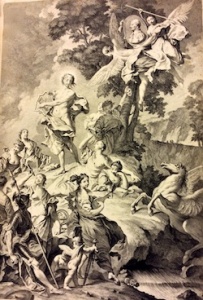Leaving aside the woes and bewitchments of Gerusalemme’s heroines for a little while, I would like to return to the war between Franks and Saracens and to the hostile stance of Torquato Tasso towards the Greeks, one of the great powers of the times, although they were called Romans back then – but this did not confuse Tasso and his contemporaries, as it did not confuse the chroniclers of the Crusades. In view of recent developments in the European world of politics and finance, and particularly in the Eurozone, it is interesting to see Tasso’s depiction of the Greeks in his epic.
Tasso used William of Tyre as his main historical source; William of Tyre, in his turn, born over a hundred years after the First Crusade, based his account on previous chronicles, among which Gesta Francorum et Aliorum Ierosolimitanorum: the great heroes in that narrative are Bohemond and his nephew – none other than our old acquaintance, Tancred. The Gesta were hostile towards the Greek emperor Alexius I Comnenus, who did not trust Bohemond and was not particularly keen to allow the rather unruly bands of crusaders to devastate his lands. For Tasso, Alexius is of course ‘the treacherous emperor of the Greeks … with his wonted cunning’ (I.69) (Albert of Aachen’s chronicle, on the other hand, paints a much more favourable picture of the emperor, who had the difficult role of balancing his moral obligation to the Christian armies with consideration of his own people…)
In Canto One, Tasso describes the various armies participating in the Crusade. This is how he presents the Greeks:
Two hundred ride behind them, Grecian – born,
each armed so lightly that it seems he lacks
all steel, with scimitars athwart their sashes worn,
and bows and quivers rattling on their backs.
Their wiry steeds, well fed on little corn,
are tireless in long treks and swift attacks.
Quick to maraud and quick to quit the fight,
roving and scattered, they wage war by flight. (I.50)
Tasso’s description seems to refer rather to Ottoman Turks (e.g. ‘scimitars athwart their sashes worn’) or Arabs (their wiry steeds, well fed on little corn’) rather than to offer historical representations of Byzantine Greeks. (And this conflation has its own significance, too). Tasso writes over a hundred years after the Fall of Constantinople to the Ottomans in 1453, and barely ten years after the Battle of Lepanto, in 1571, in which the Ottoman Fleet was defeated by a Holy League of the Catholic states of the Mediterranean. (Bonus info: Miguel de Cervantes fought in that battle and was wounded, too!)
Tatinos rules that band, the only Greek
who joined the Latin armies. Oh, the shame!
the crime! These wars – were they too far to seek,
right at your doorstep, Greece? And yet you came
to lounge, a lazy spectator and weak,
who waits to see the outcome of the game?
If you are now a slave, your slavery
is (don’t complain!) justice, not infamy. (I.51)
In Greek mythology, the Nine Muses, daughters of Zeus and Mmenosyne (=Memory), protected the Arts and Sciences. In this 1745 illustration of Jerusalem Delivered by Giambattista Piazzetta, you can see the Muses on Mt Helicon, their residence, while two winged figures are carrying a cameo with Torquato Tasso’s portrait.
Sp Coll Hunterian Cd.2.1., Special Collections, University of Glasgow Library.
The scornful tone and the belief that the Greeks brought their slavery upon themselves due to their deceit, weakness, and indolence seem to have initiated a narrative tradition of hostile and deprecatory assessment which is strangely echoed in similar remarks in Western Europe today on the ‘lazy’ and ‘untrustworthy’ Greeks. What Tasso cannot mention – since it wouldn’t fit in the time-frame of Gerusalemme Liberata, having happened about a hundred years after the First Crusade – is that those brave and honest Frankish crusaders led the Fourth Crusade against Constantinople; that first Fall of the City in 1204 weakened the already faltering Byzantine Empire considerably, and eased off the work of the Ottomans in 1453. Yet, according to Tasso and the mainstream narrative in the centuries to follow, it was the Greeks who were treacherous:
The faith of Greeks – who knows not how it fares?
One treason shows all treason they can do –
no, thousands show it, since a thousand snares
that faithless, greedy folk has laid for you. (II.72)
On the one hand, the narrative fictional tradition of the ‘Fallatia Graecorum’; on the other, the historical fact of the Fourth Crusade which shows treachery to be firmly in the Frankish court. But fiction seems to be winning over fact, every time. A rather melancholy thought, this.

